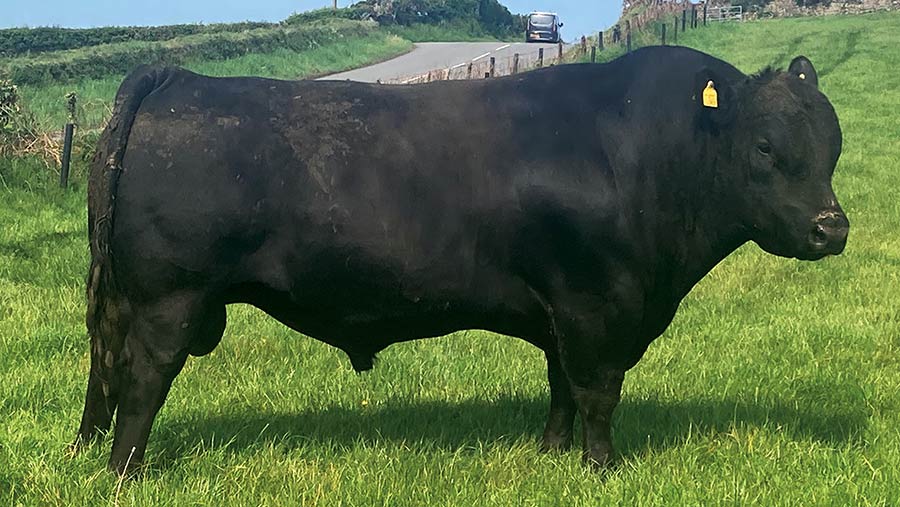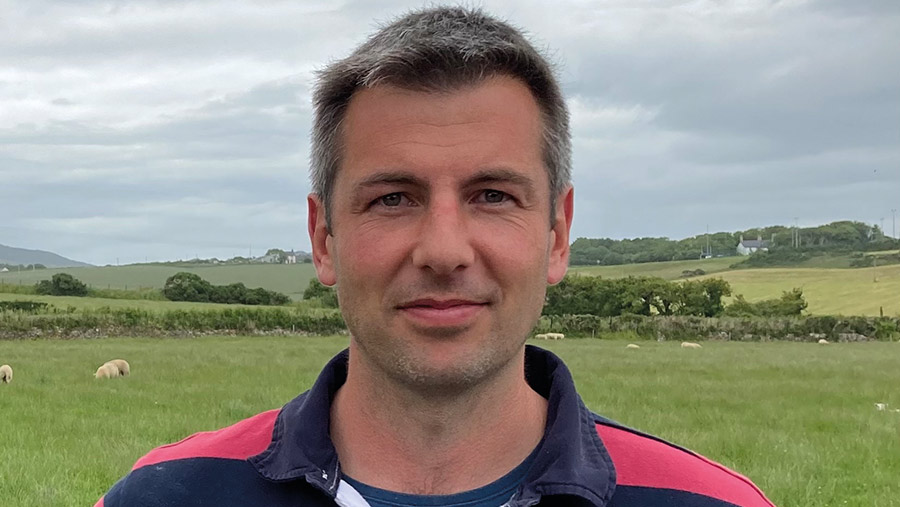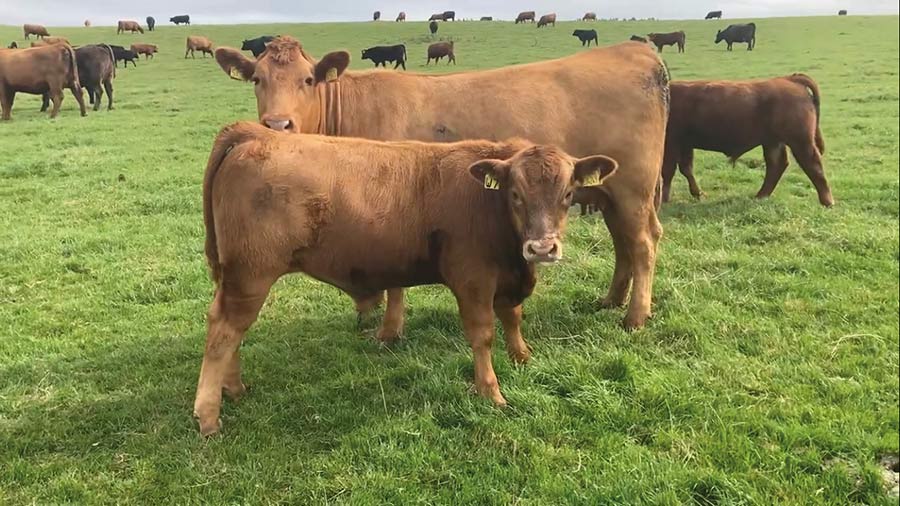9 ways a farm is lifting beef cow efficiency
 © Debbie James
© Debbie James Modelling work by the Stabiliser Cattle Company (SCC) shows that suckler beef farmers can reduce their carbon footprint by 40% with better management and the right genetics.
For Harri Parri, that better management comes down to high herd health and balanced nutrition, allowing the full potential of his 200 performance-recorded Stabiliser cows to be captured.
“It’s 40% health, 40% nutrition, and 20% genetics, so for low-carbon, profitable suckler beef you need health and nutrition as the cornerstone for the genetics to thrive,” says Harri, who farms with his wife, Elin, and parents, Richard and Rhian, at Crugeran, Pwllheli.
See also: Genomic testing mandated for all Stabiliser breeding stock
Farm facts
- 293ha (723 acres) farmed across three holdings
- 320 Lleyn and 500 Lleyn x New Zealand Suffolk ewes
- 32,000 free range layers
- 200 performance-recorded Stabilisers
For Harri, efficiency comes down to a combination of factors.
1. Cow breed
Since the family switched to the Stabilisers they have increased total wean weight by having more live calves.
Having a tighter calving block means calves spend more time on their dam and therefore wean heavier.
“We have reduced mature cow size. When we had dairy-cross cows they weighed 680kg, now they are around 630-640kg. A smaller, fatter cow will virtually live off fresh air after weaning and during mid-pregnancy,” he adds.
“With the Stabiliser we have a cow that lives very cheaply, but will perform very highly when you do put some food in front of her.”
2. Use of estimated breeding values (EBVs)
Mature cow weight, fat depth, and low birthweight come top of the list of EBVs he looks for in the herd’s breeding programme.
There are three indexes that combine relevant EBVs to give an economical value for an animal – £Weaning for maternal, £Finisher for the terminal side, and £Profit which combines both.
The Parris select for high £Profit and a good £Weaning.
3. Minimising purchased feed costs
The Parris run two adjoining farms on the Llŷn peninsula where they grow 40ha (100 acres) of barley, oats, and fodder beet in a four- or five-year rotation.
This has reduced the risk to their business as feed prices have rocketed.

Harri Parri © Debbie James
4. Body condition scoring
Dry cows typically eat 15kg dry matter (DM) a head a day and more if they get the chance, but if they are in the correct body condition score (BCS) they only need 5-6kg DM to carry them through the winter, says Mr Parri. Although he adds the cow needs to be in good condition at weaning to achieve this.
“If the cows are fat the calves will have done well too, that extra flesh on their backs is our winter hay barn or silage pit,” says Mr Parri.
“We feed the cows well over the summer and the Stabiliser genetics play a part, too – they have a positive fat EBV and are bred to thrive off grazed grass.”
In mid-pregnancy when cows are dry, Mr Parri targets a BCS of 4 to allow room for cows to lose a bit of condition and drop to 3 or 2.5. For breeding heifers, they target a daily liveweight gain (DLWG) of 0.5kg at housing.
“When we turn the heifers out in the spring, they will be grazing quality grass so there is no point in overfeeding them over winter to grow at 1kg a day – the grass will get them to the desired weight and condition running up to and during bulling.”
In fact, at turnout heifers can grow at 2kg a day.
“Our approach means we have a slightly higher empty rate in heifers than we would like – we run at 85% in-calf after six weeks, but this actually lifts herd fertility overall because the less fertile animals get found out as heifers,” he explains.
Meanwhile, the improvement is seen later with cows achieving an in-calf rate of 96-98% after a nine-week bulling period.
5. Reducing nitrogen use
Most of the arable crops have been grown without bagged N this year – only a small acreage that was planted late, in May, had a dressing to get it going.
Instead, they used poultry manure from their free-range hens.
“We halved our volume of purchased fertiliser by managing farmyard manure and chicken muck better, but sadly [fertiliser] still cost more than the total bought last year.”
Their mixed farming ethos is also good for building resilience in the soil, and they are achieving yields of 7.4t/ha (3t/acre) for barley.
6. Vaccination
The herd is bovine viral diarrhoea-accredited, at risk level 1 for Johne’s, and is vaccinated annually for infectious bovine rhinotracheitis (IBR), leptospirosis, and BVD.
Since last year, cows have also been vaccinated for rotavirus, following a severe outbreak of E coli.
“We lost a lot of calves and the performance of animals that had been infected but survived was affected, too.”
Calves are also vaccinated for clostridial diseases and pneumonia.

© Debbie James
7. Hitting growth targets
At weaning, bull calves achieve an average daily liveweight gain (DLWG) of 1.35kg and heifers 1.25kg.
The heifers are on a store ration over their first winter, but bulls are kept growing steadily at 1.4kg a day.
Once all figures are recorded and EBVs are updated at about 11-12 months old, the final cut of breeding bulls are selected. They are then transitioned to silage only, to help prepare for a summer of breeding at grass.
“We increase concentrate levels in the cull bull diet with a target of slaughtering at 15 months at 350-370kg deadweight at R-U4L grades,” says Mr Parri.
8. Good fertility
Fertility is one of the most important traits, but ease of calving and low birthweight play a part in that.
Between 75-80% of the herd calves in the first three weeks compared with the UK suckler beef average of 60%; 90% calve within the first six weeks.
“We bull 160 over the summer in nine weeks and 110 in the autumn over seven weeks, so the first calving block starts in mid-March and the second at the end of June.”
Empties are fattened for sale and surplus in-calf heifers are also sold.
9. Weaning efficiency
Spring calvers are weaned at six months in early October and the summer calvers at five months.
“Actual weaning efficiency is running at just over 40% which is not ideal, but our breeding programme is maternally driven with the cows carrying that hay barn on their backs – we could very easily lift that figure by bringing in growthier, terminal bloodlines.
“We are very mindful of losing growth because of the maternal emphasis we have in the herd, but we try to push the boundaries to see how low we can go with mature cow weight/size without compromising performance and while hitting carcass specifications.”
